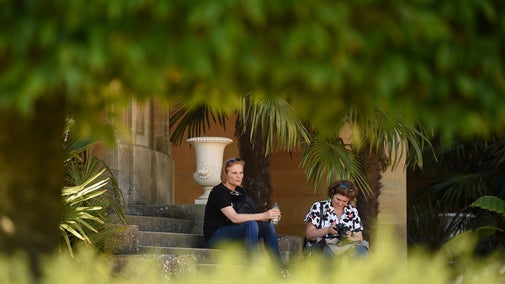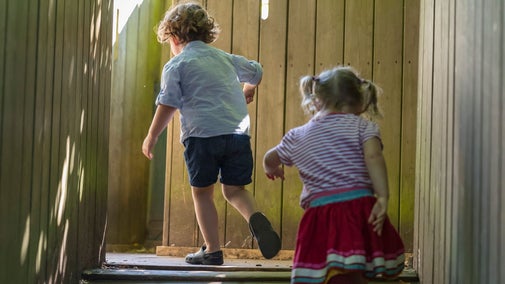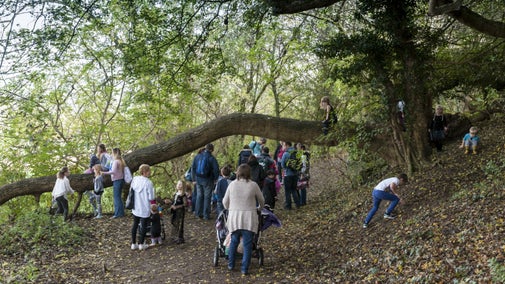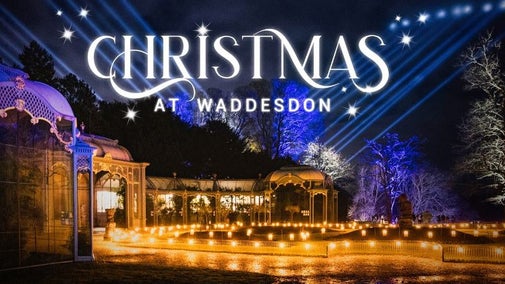
Become a member
Join today and help protect nature, beauty and history – for everyone, for ever. Enjoy access to more than 500 places with National Trust membership.
French Renaissance-style château with an extensive art collection, landscaped gardens, aviary and woodland playground.
Waddesdon, near Aylesbury, Buckinghamshire, HP18 0JH
Book a visit
| Asset | Opening time |
|---|---|
| House | 12:00 - 19:00 |
| Aviary | 12:00 - 19:00 |
| Gardens | 12:00 - 19:00 |
| Manor restaurant | 12:00 - 19:00 |
| Shop | 12:00 - 19:00 |
| Woodland playground | Closed |
| House exhibition | Closed |
| Coach House gallery | 12:00 - 19:00 |
| Food to Go outlets | 12:00 - 19:00 |
| Ticket type | With Gift Aid | Without Gift Aid |
|---|---|---|
| Adult (18+) | £15.50 | |
| Child (5-17) under 5s free | £8.00 |
| Ticket type | With Gift Aid | Without Gift Aid |
|---|---|---|
| Adult (18+) | £21.50 | |
| Child (5-17) under 5s free | £10.50 |
| Ticket type | With Gift Aid | Without Gift Aid |
|---|---|---|
| Adult (18+) | £30.00 | |
| Child (5-17) under 5s free | £14.00 |
| Ticket type | With Gift Aid | Without Gift Aid |
|---|---|---|
| Adult (18+) | £45.50 | |
| Child (5-17) under 5s free | £21.50 |
| Ticket type | With Gift Aid | Without Gift Aid |
|---|---|---|
| Adult (18+) | £13.00 | |
| Child (5-17) under 5s free | £6.00 |
| Ticket type | With Gift Aid | Without Gift Aid |
|---|---|---|
| Adult (18+) | £19.00 | |
| Child (5-17) under 5s free | £8.00 |
| Ticket type | With Gift Aid | Without Gift Aid |
|---|---|---|
| Adult (18+) | £25.50 | |
| Child (5-17) under 5s free | £11.50 |
| Ticket type | With Gift Aid | Without Gift Aid |
|---|---|---|
| Adult (18+) | £41.00 | |
| Child (5-17) under 5s free | £19.00 |
Blue Badge and limited mobility parking in visitor car park. Free shuttle bus tickets for Blue Badge holders and essential companions. Wheelchairs available upon request (first come, first served basis). Changing places facility on the ground floor of the Manor (currently closed). Grounds: partly accessible, some loose gravel paths and steep slopes. Assistance dogs are welcome in house, garden and shuttle buses.
Waddesdon, near Aylesbury, Buckinghamshire, HP18 0JH
Everything you need to know for visiting Waddesdon, including pricing, parking and access.

Waddesdon is a two pawprint rated place. Dogs are welcome on a lead all year round in the grounds at Waddesdon. They are also allowed in the Stables Café & Takeaway. You can bring along your four-legged friends to explore the grounds and wider estate together.

The interactive programme at Waddesdon brings learning to life and covers a wide range of topics using the site’s rich resources. Suitable for primary, secondary and youth groups.

Find out everything you need to know about visiting Waddesdon with a group, from discounted rates to catering.

French Renaissance-style château, built by Baron Ferdinand de Rothschild in 1874 to house his collection of fine art.
Victorian-style gardens with Parterre, ornate fountains, statuary and seasonal bedding, with Rococo-style Aviary and woodland playground.
Eat at the Manor Restaurant and Stables Café or enjoy seasonal food-to-go, all made by our talented chefs. Opening times vary, please check website for details.
Gift & Wine shop offering fine wines, gifts and unique pieces inspired by Waddesdon's art collection.
Built by the Rothschild family in the 19th century, Waddesdon was inspired by the chateaux of France. Within its dramatic architecture is an impressive collection of furniture, paintings and works of art.

From March-October, join one of our volunteer guides on a free 45-minute walk to explore the gardens, seasonal highlights, the history of Waddesdon and the Rothschild family.

Inside the Conservation Hub learn how we are implementing the Sustainability Strategy at Waddesdon and how we encourage everyone to reconnect with nature.

Please note that the playground is currently closed for works.

Discover the ornate Rococo style Aviary, an important conservation centre for endangered exotic birds.

From the woodland playground, den building and bug hunting to events at weekends and during school holidays, there’s lots for families to do at Waddesdon.

Enjoy delicious food and refreshments made by our chefs on-site daily. There are a range of food outlets located at the Manor and Stables. Options available include the Manor Restaurant, Food-To-Go and Coffee Bar, Stables Café and Takeaway. Find Rothschild wines, great gifts and one-off pieces at the Gift & Wine Shop at the Manor and visit the Stables Gift Shop too.

Follow in the footsteps of Baron Ferdinand de Rothschild on this route through woodland, past beautiful artworks and offering impressive views of the wider Waddesdon estate.

Experience the magic of Christmas as we take you on A Grand Festive Tour, with opulent decorations in the house, an immersive light and sound show in the gardens and Christmas shopping.

Celebrate Christmas with our sumptuous Festive Afternoon Tea, served in the historic Manor Restaurant.

Join Baron Ferdinand de Rothschild and his beloved dog, Poupon, on a festive trans-European tour, exploring the unique holiday traditions that light up each country’s winter season.
Celebrate Christmas with our sumptuous Festive Afternoon Tea, served in the historic Manor Restaurant.
Join Baron Ferdinand de Rothschild and his beloved dog, Poupon, on a festive trans-European tour, exploring the unique holiday traditions that light up each country’s winter season.
Step inside the house while it is closed for winter and see behind the scenes on this guided tour.
Discover the beauty of the Water Garden and its contemporary sculpture, followed by a traditional Cream Tea at the Stables Café.
Surrounded by views of Oxfordshire, the Chilterns Hills, the Vale of Aylesbury and just a train ride away from London, Waddesdon Manor, is an ideal place for relaxing with family and friends.
Explore this French Renaissance-style château built by Baron Ferdinand de Rothschild in 1874 to entertain the fashionable world and to house his collection of fine art. We're continuing the tradition today of entertainment and hospitality with events celebrating food and wine, and opportunities for you to explore our history, collections and gardens through changing exhibitions and special interest days.
Step back in time in the Victorian style gardens, gaze at flamboyant colours on the parterre amid the ornate fountains and statuary. Hear the rare and exotic birds calling from the roccoco style Aviary found in the heart of the gardens. Alternatively spend a fun filled day with the family, and have an adventure in the woodland playground which winds through the trees, making use of the natural environment to create a magical area to play. Why not explore the trail around the gardens; hunt for bugs and spot wildlife along our woodland walk?
There's fresh, homemade food including cakes and other treats from food-to-go outlets. Shop for wine, great gifts and unique pieces inspired by the collection in our Manor shop.
Waddesdon Manor is managed by the Rothschild Foundation (charitable trust) on behalf of the National Trust. All proceeds from Waddesdon's restaurants and shops is invested in the care of the gardens, house and collections.
The foundation stone at Waddesdon was laid in 1877, three years after Baron Ferdinand de Rothschild bought the estate. From hosting royals to evacuees, discover the manor’s story.

The vision of Baron Ferdinand de Rothschild, the garden was created at the end of the 19th century. He wanted to create something beautiful for his guests to see at every turn.

The Rothschilds were great collectors, and Waddesdon is known for its treasures. Discover paintings, sculptures, prints and over 300 precious objects in the Rothschild Treasury.

At Waddesdon we are committed to working in a sustainable way by protecting the environment and reducing pollution and waste wherever possible.

Discover which locations at Waddesdon played their part as Manderley, in the 2020 Netflix adaptation of Daphne du Maurier’s classic mystery.

If you enjoy meeting new people, are positive and have some time to give, why not consider volunteering? You can learn new skills, share your passions and make a real difference.


Join today and help protect nature, beauty and history – for everyone, for ever. Enjoy access to more than 500 places with National Trust membership.
By sharing your email address you’re agreeing to receive marketing emails from the National Trust and confirm you’re 18 years old or over. Please see our for more information on how we look after your personal data.